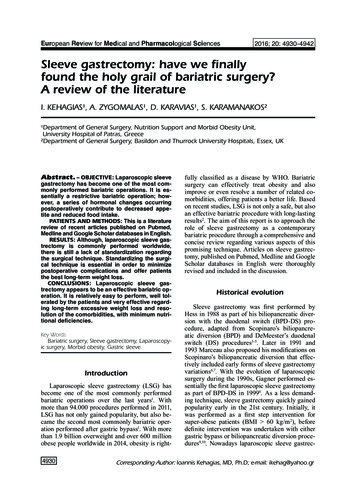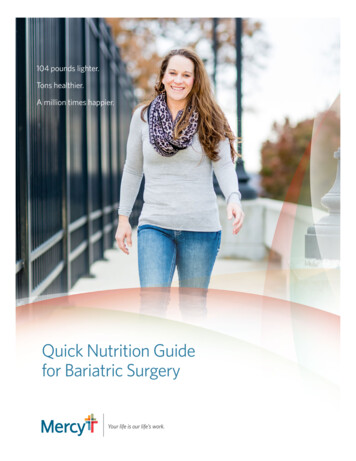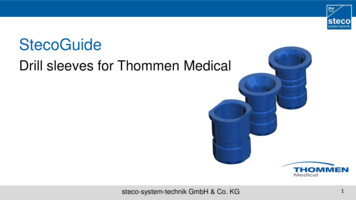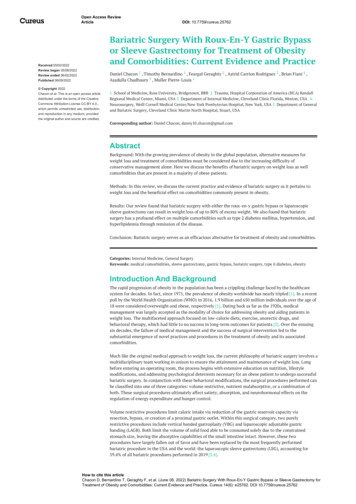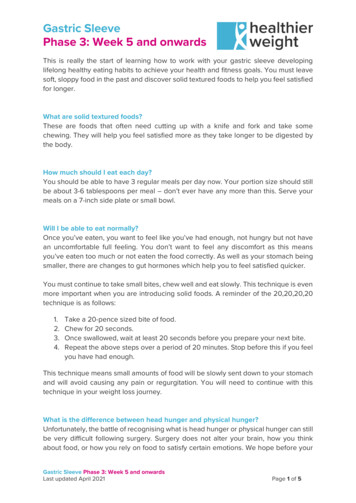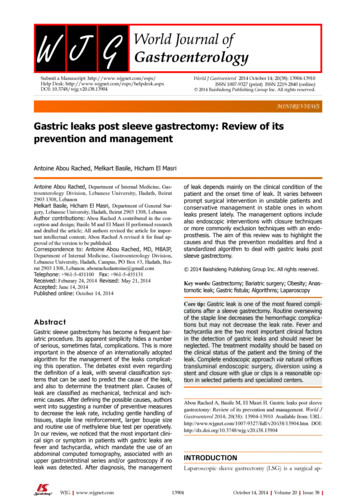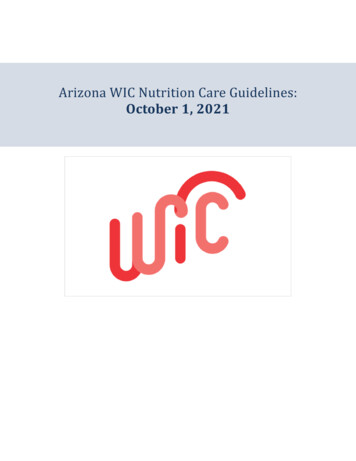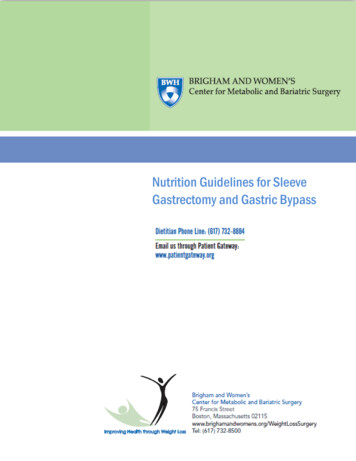
Transcription
Nutrition Guidelines for SleeveGastrectomy and Gastric Bypass0
We designed this book to help you and your family and friends understand the diet that you will follow aftersurgery. You need to commit to healthy lifestyle habits for the rest of your life to be successful with surgery. Itis still possible for people to overeat and gain weight after bariatric surgery. We hope the guidelines in thisbook and the support from our team will help you to have a healthy and happy life after surgery.In this book, you will find:Gastric Bypass & Sleeve GastrectomySkills for Success.Physical Activity.Getting Ready for Surgery.Stage 1: Fluids.Stage 2: Protein Shakes.Stage 3A: Soft Textures.Vitamin/Mineral Supplements.Stage 3B: Soft Textures.Stage 4: Regular Textures.Serving Sizes.Possible Problems and Solutions.23456791112152026You will meet with a dietitian several times before and after surgery.You can have extra appointments if desired.Typical Dietitian Appointment Schedule*Before Surgery: Nutrition Class Nutrition Assessment Nutrition Follow-Ups as neededAfter Surgery 2-3 week group after surgery 6-8 weeks 3 months 6 months 9 months 1 year After 1 year, meet with dietitian twice per year (every 6 months) forever* Individual appointments are 30 minutes; groups are 45-60 minutes.1 Center for Metabolic and Bariatric Surgery 6/2017
The Surgeries There are two main ways that gastric bypass and sleevegastrectomy will help you to lose weight and become healthier. Restriction – Your smaller stomach will limit how muchfood you can eat in one sitting. The restriction willdecrease over time so you will need to rely on healthylifestyle habits.Metabolic Changes – Stomach hormones and someother signals in your body change after surgery. Thiscan make people feel less hungry and can help withhealth conditions like diabetes. Your body can adapt tothis change in gut hormones over time and you willprobably feel hunger again.You are usually in the hospital for 2 nights after gastric bypassor sleeve gastrectomy.Gastric BypassSleeve GastrectomyDumping SyndromeAbout half of gastric bypass patients will have dumping syndrome. Dumping syndrome is the body’s reaction toeating and drinking foods and beverages with added sugar, such as cakes, cookies, candies, juice, and soda.The foods or beverages pass too quickly through the stomach pouch. This causes symptoms such as nausea,cramping, cold sweats, dizziness, extreme tiredness, and an increase in heart rate. Usually the symptoms willstop in 1-2 hours. Lying down can help patients to recover. Eating high-fat foods, such as fried foods, causessimilar symptoms.Sleeve gastrectomy patients usually do not have dumping syndrome. However, all patients are encouraged toavoid foods and beverages with added sugar and high-fat foods.2 Center for Metabolic and Bariatric Surgery 6/2017
Skills for SuccessBariatric surgery is only a tool. You must commit to a healthy lifestyle (diet, exercise, behaviors) to staysuccessful forever.FluidsChoose sugar-free, non-carbonated fluids.Sip fluids throughout the day.Know the signs of dehydration: headaches, dizziness, dark urine.No caffeine until stage 4.Avoid alcohol after surgery.Eating BehaviorsTake bites the size of a dime.Chew, chew, chew; puree the food with your teeth.Wait between bites to see how your stomach feels.Aim for 30-40 minute meals.Make Eating MindfulAvoid grazing, nibbling, and picking throughout the day.Have regularly scheduled eating events.When you’re eating, just eat! Avoid distractions.Separate Fluids from SolidsWait to drink fluids until 30 minutes after you eat solid food.It’s okay to drink before eating.Why? Eating and drinking at the same time can overfillyour stomach and make you feel sick.Plan AheadLife is busy now and it will be busy after surgery too.You will make healthier choices when you plan ahead.Pack food and fluids for busy days.Bring your own food to social events if you aren’t surewhat will be served.Stay AccountableTrack yourself: food and beverage choices, exercise, and weight aregood places to start.Keep your appointments with the CMBS team.Let your support team know how they can help you stay on track.3 Center for Metabolic and Bariatric Surgery 6/2017
Physical ActivityMost people need to exercise at least 250 minutes (over 4 hours) each week to maintain weight loss. It takestime to build up to that amount of exercise but we are here to help you. Even if you don’t reach that level ofexercise, any amount of exercise will benefit your body. You can even break your exercise up into smalleramounts of time during the day. It's about finding what works best for you!Here are some ideas for increasing your physical activity before and after surgery.* Walk more!oWalk the dog; go for a walk with a friend, a neighbor, or your children.oGet up to talk to co-workers instead of sending an email or making a phone call.oWear a pedometer to track your steps and challenge yourself to increase steps over time.oTake a "walking break" at work instead of a coffee break.oIf you take the bus or subway, get off a few stops early and walk.oPark your car farther away at shopping centers and walk through the parking lot.oTake the stairs instead of the elevators.oDuring foul weather, get exercise by walking in the mall. Make exercise a family event. Go for a walk together after dinner or on the weekend. Keep exercise clothes in your car to make sure you will go to the gym. To decrease impact on your joints, try pool exercises, water aerobics, or a stationary bicycle.*oPlease refrain from swimming until your first appointment after surgery. Turn up the music and dance. Do yard work, gardening, or household chores that require brisk movement. Check out exercise videos online. Try chair exercises.What does 250 minutes of exercise look like in a SaturdayTotalType of ExerciseHiked with familyAerobics exercise video10-minute walk; hand weightsZumba class3 10-minute walksElliptical; weight machinesYardworkWhat are the benefits of exercise besides weight control? Improves mood Keeps body strong Boosts energy Promotes better sleepDuration60 minutes30 minutes10 minutes45 minutes30 minutes45 minutes30 minutes250 minutes Improves bone healthImproves heart health* Remember to check with your primary care doctor or surgeon before starting any strenuous exercise.However, you may start walking right after surgery.4 Center for Metabolic and Bariatric Surgery 6/2017
Getting Ready for SurgeryWhat to Buy Before SurgeryMeasuring Cups & SpoonsSugar-free FluidsFood ScaleProtein Shakes*Vitamin & Mineral Supplements** Choose protein shakes and vitamin & mineral supplements from the shopping guides.Pre-Op DietYou will receive a pre-op diet on a separate sheet of paper.Remember to start your pre-op diet2 weeks before surgery.Surgery DatePost-Op Diet StagesStage 1: Fluids - Starts and ends in hospitalStage 2: Protein Shakes - Starts in hospitalStage 3A: Soft Textures - Starts 10 days after surgeryStage 3B: Soft Textures - Starts 20 days after surgeryStage 4: Regular Textures - Starts 40 days after surgery5 Center for Metabolic and Bariatric Surgery 6/2017
Post-Op Diet Stage 1: FluidsStarts: In the hospital on either the day of surgery or the first day after surgery.Lasts for: Up to 1 dayWhat to do: Sip sugar-free, non-carbonated, non-caffeinated fluids throughout the day.Examples of fluids: Water Crystal Light, MiO, or other sugar-free flavorings Decaf coffee and tea Broth Fruit-flavored water (Hint Water or homemade by floating fruit in water) Sugar-free sports drinks (PowerAde Zero, Propel)o G2 only recommended with severe diarrhea and vomitingYou will be in the hospital for this entire diet stage and you will be given the right types of fluids. The nurses willguide you to sip enough fluids during the day.Stage 1 Key Points: Fluids are the number one priority. You will only be able to sip small amounts of fluid at one time. Pace yourself throughout the day. Gulping and chugging fluids will cause stomach pain. Avoid caffeine until Stage 4. It irritates the stomach. Carbonation can cause gas, belching, bloating, and stomach discomfort. Some people never toleratecarbonation after surgery. You can use artificial sweeteners such as Equal (Aspartame), Sweet & Low (Saccharin), Splenda(Sucralose), PureVia and Truvia (Stevia), and Nectresse (monk fruit).6 Center for Metabolic and Bariatric Surgery 6/2017
Post-Op Diet Stage 2: Protein ShakesStarts: In the hospital on either the first or second day after surgery.Lasts for: 8-9 daysWhat to do: Sip fluids throughout the day. Drink a protein shake 3-4 times per day. If you haven’t finished theprotein shake after one hour, stop drinking it. Fluids are still the number one priority.Fluid Goal: 48-64 ounces (fluid guidelines listed in stage 1). This does not include your protein shakes.Protein Goal: 60-70 grams (number of shakes per day depends on brand of protein shake)It is normal to not reach your fluid and protein goals right away. Just do your best each day.Protein Shake Nutrition GuidelinesEach protein shake* should have: at least 15 grams of protein 100-200 calories less than 20 grams of sugar* A typical protein shake is 8-11 ounces.If you are using a protein powder, remember to add theprotein, calories, and sugar from the liquid you aremixing with. For example, 8 ounces of skim milk has 8grams protein, 90 calories, and 12 grams sugar.Here is where you’ll find these numbers on a nutrition fact label:Using a powder? Remember toadd the protein, calories, andsugar from the liquid you aremixing with.7 Center for Metabolic and Bariatric Surgery 6/2017
Post-Op Diet Stage 2: Protein Shakes (continued)Lactose Intolerance:Lactose is the natural sugar in milk. Sometimes after surgery, your body cannot digest this sugar. This causesproblems like nausea, cramping, bloating, gas, and/or diarrhea. It is not normal to have these problems fromdrinking protein shakes. You might be experiencing lactose intolerance.What if you are experiencing lactose intolerance? Stop drinking protein shakes for 24 hours. Keep drinking your fluids. When you start drinking protein shakes again, avoid any shakes that have milk, ‘whey proteinconcentrate,’ or ‘milk protein concentrate’ in the ingredient list. Instead, choose a protein shake that is made from ‘whey protein isolate.’ The lactose has been filteredout of whey protein isolate. Call your dietitian if you need help finding lactose-free options.Having Trouble with Protein Shakes?If the taste is bothering you: Flavor your shakes with extracts. You can find extracts in the baking aisle at the grocery store. You onlyneed a couple drops so go slowly and taste-test along the way. Flavor your shakes with sugar-free syrups. You can find sugar-free syrups at the grocery store but youwill have more flavor options if you order online. Common brands are Da Vinci Gourmet and Torani. Flavor your shakes with spices such as cinnamon, ginger, nutmeg, and cloves. Flavor your shakes with unsweetened cocoa powder or powdered peanut butter; limit to 1 tablespoontotal per day.If the smell is bothering you: Drink your shake from a bottle with a small opening. Drink your shake using a straw. Drink your shake at a very cold temperature.If you need to chew: Pour your protein shake into a popsicle or ice cube tray and freeze to make a protein popsicle. Semi-freeze your protein shake or blend it with ice to make a slushy.Stage 2 Key Points: Be aware of signs of dehydration: sudden lightheadedness or dizziness, headaches, and urine colorbecoming darker throughout the day. If you’re struggling to tolerate fluids, it’s helpful to try different temperatures for your beverages. Somepatients prefer ice cold while others prefer room temperature or warmer beverages. Keep track of the amount of protein shakes and fluids that you are drinking using a food log. If you cannotfinish a protein shake in a one hour period, you can save it for the next meal time. Changes in bowel regimens, such as less frequent movements or loose stools, are normal. If you arehaving discomfort, contact the bariatric team.8 Center for Metabolic and Bariatric Surgery 6/2017
Post-Op Diet Stage 3A: Soft TexturesStarts: 10 days after your surgery dateLasts for: 10 daysWhat to Do: Keep sipping fluids. Have a protein shake or eat a protein food 5-6 times per day. Start takingvitamin and mineral supplements. Please only eat the foods listed on this page.Fluid Goal: 48-64 ounces (fluid guidelines listed in stage 1)Protein Goal: 60-70 grams/dayProtein Foods Fat-free Greek yogurt (without fruit chunks) Low-fat cottage cheese Part-skim ricotta cheese Tofu Vegetarian refried beans (black or pinto) Protein shakes and powdersHow to Count Grams of ProteinThis is a container of Greek yogurt. The label says that the serving size is 1 container. That means that eachcontainer has 15 grams of protein. If you eat the whole container, you have eaten 15 grams of protein.However, with your small stomach, you might not have room for the whole container. If you eat half of thecontainer, you have eaten 7.5 grams of protein.Non-Protein Foods Fat-free or light yogurt Unsweetened applesauce Canned pears or peaches (in own juice or water; no syrup) Soft banana Oatmeal, cream of wheat, or farina Sugar-free pudding9 Center for Metabolic and Bariatric Surgery 6/2017Try to meet the protein goal of 60-70grams each day before choosingfoods from this list. Your stomachwill fill up quickly from the proteinfoods so you might not have roomfor the non-protein foods.
Post-Op Diet Stage 3A: Soft Textures (continued)Stage 3A Key Points: Remember to drink plenty of fluids to stay hydrated and wait 30 minutes after eating to drink. You might not feel hungry but you still need to eat regularly. Space out your eating events evenly during the day. Some days you won’t have room for everything. Do your best to reach your protein goal. Stop eating or drinking at the first sign of fullness. Sometimes this can feel like chest pressure ornausea. Keep track of how much you are eating and drinking using a food log (journal, apps, etc.).Example DayEating Event1Food or Protein ShakeMacho Mocha Cinnamon Shake*Grams Protein28 grams2¼ cup Key Lime Custard*7 grams31.5 ounces pan-fried tofu6 grams4¼ cup oatmeal cooked with ¼ scoop protein powder7 grams5¼ cup cottage cheese with chive7 grams6¼ cup Chocolate Almond Bliss with ricotta cheese*7 gramsTotal 62 grams*Ask your dietitian for these recipes or find them on our website: www.brighamandwomens.org/cmbs10 Center for Metabolic and Bariatric Surgery 6/2017
Post-Op Diet Stage 3A: Soft Textures (continued)Vitamin and Mineral Supplements:You will need to take vitamin and mineral supplements for the rest of your life after surgery. We recommendthat you start with chewable or liquid supplements until stage 4. Over time, if you are comfortable swallowing a‘petite’ tablet or cutting a pill in half, you can swallow your supplements.Multivitamin with Minerals: Take a ‘complete’ multivitamin(s) daily; dose will vary based on brand of multivitamin. Complete multivitamins contain iron, zinc, folic acid, and copper. Avoid gummy or soft chew multivitamins – these don’t have all of the right nutrients. Separate multivitamin(s) with iron from calcium by at least 2 hours.Vitamin B12: Take 350-500 micrograms vitamin B12 daily in the form of a tablet or liquid. You can take vitamin B12 at any time or with any other supplements. You can also get vitamin B12 in a nasal spray or injection. Your multivitamin might have enough vitamin B12 in it. This will be listed on your shopping guide.Calcium Citrate with Vitamin D: Take 1200-1500 mg of calcium citrate daily split into 2-3 doses. Your body can only absorb 600 mg of calcium at one time. Separate calcium doses by at least 4 hours. Separate calcium from multivitamins by at least 2 hours. You can also meet your daily calcium needs from food and supplements. Talk to your dietitian.Other Supplements:Some patients may need extra vitamins and minerals, such as iron, vitamin D, or B vitamins. We will checkyour vitamin and mineral levels regularly through lab tests and discuss extra supplements as needed.Here are three suggestions for separating your supplements:Scenario 1Multivitamin(s) vitamin B12Scenario 2Scenario 3500 mg calcium600 mg calciumWait at least 2 hours500 mg calciumWait at least 2 hoursMultivitamin(s) vitamin B12Wait at least 2 hoursMultivitamin(s) vitamin B12Wait at least 4 hoursWait at least 2 hours500 mg calcium500 mg calciumWait at least 4 hours500 mg calciumWait at least 4 hours500 mg calcium11 Center for Metabolic and Bariatric Surgery 6/2017Wait at least 2 hours600 mg calcium
Post-Op Diet Stage 3B: Soft TexturesStarts: 20 days after your surgery dateLasts for: At least 21 days / 3 weeksYour stomach has not fully healed yet so you need to stay on Stage 3B for at least 3 weeks.What to Do: Keep sipping fluids. Have a protein shake or eat a protein food 5-6 times per day. Keep takingvitamin and mineral supplements. Please only eat the foods listed on this page and in previousstages.Fluid Goal: 48-64 ounces daily (fluid guidelines listed in stage 1)Protein Goal: 60-70 grams/dayExample Plate – it might be this small!Food Choices in Stage 3BProtein Foods Fat-free Greek yogurt (without fruit chunks) Low-fat cottage cheese Part-skim ricotta cheese Tofu Chicken or turkey (dark meat is fine) Fish (flaky fish like tuna, cod, haddock,salmon, and tilapia) Egg, egg whites, or egg beaters Soy-based veggie burger Beans and lentils Protein shakes or powdersProtein Foods –Eat these first.Non-Protein Foods Fat-free or light yogurt (non-Greek) Unsweetened applesauce Canned pears or peaches (in own juice or water;no syrup) Soft banana Oatmeal, cream of wheat, or farina Tomato sauce Well-cooked vegetables (non-starchy or starchy)with no skins or peels Reduced-fat or light cheeseFats Non-Protein Foods – Youmay be too full for these.How to Count Grams of Protein(if the food does not have a nutritionfacts label)7 grams of protein is equal to:1 ounce chicken/turkey/fish1 egg¼ cup egg substitute2 oz firm tofu/3 oz soft tofu½ cup beansTub margarine or oilLight mayonnaise or salad dressingHummusAvocadoSmooth nut butter (not crunchy)12 Center for Metabolic and Bariatric Surgery 6/2017Fat orCondimentor
Post-Op Diet Stage 3B: Soft Textures (continued)Here are some examples of eating events in stage 3B. You will receive recipe ideas from the dietitianand you can find them on the CMBS website: www.brighamandwomens.org/cmbs1 teaspoonketchupSeasonings andspices are fine! Youdon’t need to eatbland food. It justneeds to be soft.1 egg1 Tablespoon oatmeal1 teaspoonlight mayo1.5 ounces tunaDash ofhot sauce1 Tablespoon canned pears¼ cup non-fatrefried beans1 Tablespoon melted cheese1 TablespoonavocadoTurkey Chili1.5 ounces ground turkey1/4 cup tomato sauce13 Center for Metabolic and Bariatric Surgery 6/2017
Post-Op Diet Stage 3B: Soft Textures (continued)Stage 3B Key Points: Food can get ‘stuck’ in your chest. If this happens, don’t panic and don’t drink water. Stay calm, movearound, and it will pass. Afterwards, think about what might have gone wrong.o Ate too fast? Take 30 minutes for each eating event and pause after each bite.o Didn’t chew enough? Chew until your food is pureed by your teeth.o Food too tough? Make sure you are only eating stage 3A and 3B foods.o Stomach too full? Fullness can feel like chest pressure or nausea.o Food too dry? Dry foods are hard to tolerate. Keep meat tender and moist. Use a slow cooker, marinate meats, cook in foil packets, avoid over-cooking. Add broth when reheating meat in the microwave to keep it moist. Dehydration can still happen. You are likely getting back to your daily routine and will be busy with yourscheduled eating times. Remember to drink your fluids in between eating times. You might not feel hungry but you still need to eat regularly. Space your eating events evenly during theday, about every 3 hours. Some days you won’t have room for everything. Do your best to reach your protein goal. It’s normal to not tolerate certain textures the first time you try them. If you have trouble with a foodeven when you are eating very carefully, avoid the food for 2-3 weeks before trying again.14 Center for Metabolic and Bariatric Surgery 6/2017
Post-Op Diet Stage 4: Regular TexturesStarts: 40 days after your surgery date – Only if meeting protein goals regularly in Stage 3BLast for: Forever, but your meal plan will change over time.What to Do: Keep sipping fluids. Use the meal plan below as guidance for a balanced diet. Keep takingvitamin and mineral supplements.Fluid Goal: 48-64 ounces (fluid guidelines listed in stage 1)Protein Goal: 60-70 grams/dayMeal Plan8 cups of fluid 8 protein servings 2 vegetable servings 2 fruit servings 1 dairy serving 2 fat servings 3 starch servings Refer to pages 20-25 for serving sizes in each food group.How do I start in Stage 4? In Stage 4, you will start trying new types of foods. You may not tolerate every food you try so bepatient with your stomach. Tolerance improves with time. See below for possible ‘problem foods.’ Use the meal plan for guidance. Each checkbox is a serving of food from that food group. In the earlymonths after surgery, you won’t have room for all of the foods in the meal plan. Focus on foods fromthe protein, vegetable, and fruit groups first. The meal plan is not one size fits all. Your dietitian will help you change your meal plan as needed.Possible ‘Problem Foods’Your stomach can be sensitive for 3-6 months after surgery, and sometimes longer. The followingfoods have unique textures that may be difficult to tolerate if eaten too soon. Be cautious!Protein: Tough red meat, hamburger, lobster, scallops, clams, shrimpFruits: Stringy, thick skins, peels (like oranges, grapes, pineapple)Vegetables: Stringy, fibrous (like asparagus, peapods, celery)Starches: Rice, pasta, doughy breads, popcorn15 Center for Metabolic and Bariatric Surgery 6/2017
Post-Op Diet Stage 4: Regular Textures (continued)Stage 4 Key PointsEat protein foods first, then vegetables or fruits, andeat starches last. Use fats as a flavoring or to keepfoods moist.This will be lifelong!Use your “Stage 4 Meal Ideas” handout for recipe ideas.Self-monitorTrack protein and fluids. Trackingregularly will help you stayaccountable and more consistent withmeeting your goals.Listen to your stomachStop eating at the first sign of fullness, whichmay feel like pressure in your upper chest.Hunger may increaseThis is normal. The hormone changesfrom surgery might not last forever.Foods high in protein and fiber helpcontrol hunger so fill up on these foods.Avoid eating out of habit or frombehavioral triggers like boredom,stress, and emotions.Be aware of picking or grazingAre you eating something just because it’savailable to you? Avoid unplanned eatingmoments and try to control your environmentto minimize these opportunities. Havescheduled and structured eating times.Work towards a balanced dietLearn which food groups the foods you eatbelong to: Protein, Vegetable, Starch, etc.Work towards keeping these foods withinthe meal plan outlined by your dietitian.16 Center for Metabolic and Bariatric Surgery 6/2017
Post-Op Diet Stage 4: Regular Textures (continued)Sample Meal PlansThese are examples to show you how the amount you can eat will change over time. Each person can choosetheir own foods based on their preferences and their tolerance.Just starting Stage 4 – about 6 weeks after surgery8 cups of fluid 8 protein servings 2 vegetable servings 2 fruit servings 1 dairy serving 2 fat servings 3 starch servings Time8 AM9 AM10 AM11 AM1 PMFood1 ½ scrambled eggs (1 ½ protein), ¼banana (½ fruit)4 PM5 PM6 PM7 PM8 PM9 PM10 PMProtein (g)108 oz decaf tea3 oz fat-free Greek yogurt (1 protein), ½cup strawberries (½ fruit)78 oz waterHomemade chili: 1 oz turkey (1 protein),¼ cup stewed tomatoes (½ vegetable),1 tablespoon avocado (1 fat)2 PM3 PMFluid (oz)78 oz Crystal Light1 scoop protein powder (2 ½ protein) in8 oz skim milk (1 dairy)268 oz tea8 oz water1 oz fish (1 protein), ¼ cup cookedgreen beans (½ vegetable)78 oz water8oz Crystal Light¼ cup ricotta cheese (1 protein)78 oz tea64 ozTotal64 gramsFat/Condiment1 Tbsp avocadoEating Event ExampleProtein Foods1 oz turkey17 Center for Metabolic and Bariatric Surgery 6/2017Non-Protein Foods¼ cup stewed tomatoes
Post-Op Diet Stage 4: Regular Textures (continued)Feeling comfortable with Stage 4 – about 8 months post-op8 cups of fluid 8 protein servings 2 vegetable servings 2 fruit servings 1 dairy serving 2 fat servings 3 starch servings Time8 AM9 AM11 AM12 PMFood1 scoop protein powder (2 ½ protein) in8 oz skim milk (1 dairy)7 PM8 PM9 PMProtein (g)268 oz decaf tea8 oz water1.5 oz tuna (1.5 protein), 1 cup saladvegetables (lettuce, tomatoes, onion,cucumber) (1 vegetable), 1 Tbsp lightdressing (1 fat)2 PM3 PM4 PM5 PM6 PMLiquid (oz)148 oz Crystal Light6 oz Greek yogurt (2 protein)148 oz decaf tea8 oz water1 oz ground turkey (1 protein), ¼ cupbeans (½ protein, ½ starch), ½ cupstewed tomatoes (1 vegetable)108 oz water8oz Crystal Light¼ cup roasted chickpeas (½ protein, ½starch), 2 clementines (1 fruit)10 PM38 oz decaf tea64 ozTotal67 gramsEating Event ExampleProtein2 oz tunaVegetablesor Fruits1 cuplettuce,tomatoes,onions,cucumber18 Center for Metabolic and Bariatric Surgery 6/2017StarchNone – nostomachspace!Fat/Condiment1 Tbsp lightdressing
Post-Op Diet Stage 4: Regular Textures (continued)Long-term Stage 4 – About 2 years post-op8 cups of fluid 9 protein servings 2 vegetable servings 2 fruit servings 1 dairy serving 2 fat servings 3 starch servings Time8 AM9 AM10 AM11 AM12 PMFood6 oz Greek yogurt (2 protein), ½ banana (1fruit), ½ cup bran flakes (1 starch)Liquid (oz)8 oz decaf tea8 oz water3 oz chicken (3 protein), lettuce, tomato, onion(1/2 vegetable), 1 sandwich thin (1 starch), 1tablespoon avocado (1 fat)2 PM3 PM4 PM5 PM6 PM7 PMProtein (g)14218 oz Crystal Light8 oz tea½ cup cottage cheese (2 protein), 1 cupblueberries (1 fruit), 2 tablespoons slicedalmonds (1 fat)148 oz water8 oz water2 oz lean ground turkey meatballs(2 protein), 1/2 cup whole wheat pasta (1starch), ¼ cup tomato sauce(1/2 vegetable), ½ cup wilted spinach(1 vegetable), ¼ cup light mozzarella(1 dairy)148 PM9 PM8oz Crystal Light8 oz tea64 ozTotalVegetables orFruits½ cup wiltedspinach, ¼ cuptomato sauce19 Center for Metabolic and Bariatric Surgery 6/201763 gramsProtein2 oz turkeymeatballsStarch½ cupwholewheat pastaDairy¼ cup mozzarella
Serving SizesProtein Foods1 servingof protein 1 ounce chicken1 ounce turkey1 ounce fish or shellfish1 ounce beef1 ounce pork2 oz firm tofu/3 oz soft tofu¼ cup non-fat cottage cheese¼ cup non-fat ricotta cheese3 oz Greek yogurt (1/2 individualcontainer)½ cup beans*¼ cup egg substitute1 egg 7 gramsof protein*1/2 cup beans is equal to 1 protein serving 1 starch serving1 ounce or 1 serving about 7 grams of protein2 ounces or 2 servings about 14 grams of protein3 ounces or 3 servings about 21 grams of proteinEach ounce of protein food contains 35-55 calories, depending on the fat content. Choose lower fat protein foods (like skinless chicken breast, 99% fat free ground turkey). Limit red meat (beef, lamb, pork). Processed meats can increase a person’s risk of colorectal and stomach cancer. Processed meatsinclude hot dogs, pepperoni, salami, sausages, corned beef, ham, bacon, pastrami, and any othermeats that have been cured, smoked, salted or treated with any chemical preservatives. The dietitiancan provide you with more information about processed meats.Remember to eat at least 8servings of protein everyday!20 Center for Metabolic and Bariatric Surgery 6/2017
Serving Sizes (continued)Non-Starchy VegetablesEach vegetable serving contains 5 grams of carbohydrates (2-3 grams of fiber per serving), 2 grams of protein,0 grams of fat, and 25 calories.Fresh and frozen vegetables are ready to eat! Rinse canned vegetables to remove some salt.1 servingofvegetables½ cup cookedvegetablesor1 cup rawvegetables Examples of non-starchy vegetables:ArtichokeAsparagusBeetsBroccoliBrussels lantGreen d GreensSpinachSproutsSnap PeasSummer SquashTomatoWater ChestnutsZucchiniStarchy vegetables (corn, peas, potatoes, plantains, winter squash)are found on the Starches List (page 25).Aim for at least 2 servings ofnon-starchy vegetables everyday!21 Center for Metabolic and Bariatric Surgery 6/2017
Serving Sizes (continued)FruitsEach fruit serving contains 15 grams of carbohydrates (2 or more grams of fiber), 0 grams of protein, 0 gramsof fat, and 60 calories.Use fresh, frozen or canned fruits with no sugar added.Eat fruit in its whole form instead of blending or juicing. Whole fruit will fill you up more!Fresh, Frozen, & Unsweetened Canned FruitApple (2 in. across)Applesauce (unsweetened)Apricots (canned)Apricots (medium, fresh)Banana (8 in. long)BlackberriesBlueberriesCantaloupeCherries (canned)Cherries (fresh).Figs (fresh)Grapefruit (medium)Grapefruit (segments)GrapesHoneydew melonKiwiMandarin orangesMangoNectarine (2 ½ in. across)Orange (2 ½ in. across)PapayaPeach (fresh)Peaches (canned)Pear (fresh)Pears (canned)PersimmonPineapple (canned)Pineapple (fresh)PlumPomegranateRaspberriesStrawberries (whole)T
Gastric Bypass Sleeve Gastrectomy Dumping Syndrome About half of gastric bypass patients will have dumping syndrome. Dumping syndrome is the body's reaction to eating and drinking foods and beverages with added sugar, such as cakes, cookies, candies, juice, and soda. The foods or beverages pass too quickly through the stomach pouch.
